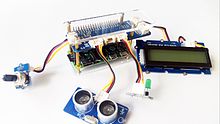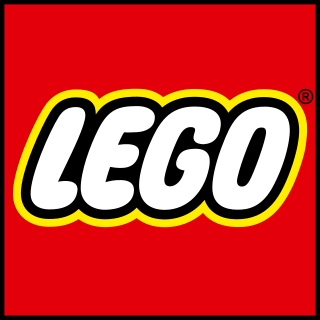
Lego is a line of plastic construction toys manufactured by the Lego Group, a privately held company based in Billund, Denmark. Lego consists of variously coloured interlocking plastic bricks made of acrylonitrile butadiene styrene (ABS) that accompany an array of gears, figurines called minifigures, and various other parts. Its pieces can be assembled and connected in many ways to construct objects, including vehicles, buildings, and working robots. Assembled Lego models can be taken apart, and their pieces can be reused to create new constructions.

Robot-sumo, or pepe-sumo, is a type of robot combat in which two robots attempt to push each other out of a circle. The robots used in this competition are called sumobots.

Lego Mindstorms is a discontinued line of educational kits for building programmable robots based on Lego bricks.
leJOS is a firmware replacement for Lego Mindstorms programmable bricks. Different variants of the software support the original Robotics Invention System, the NXT, and the EV3. It includes a Java virtual machine, which allows Lego Mindstorms robots to be programmed in the Java programming language. It also includes 'iCommand.jar' which allows you to communicate via bluetooth with the original firmware of the Mindstorm. It is often used for teaching Java to first-year computer science students. The leJOS-based robot Jitter flew around on the International Space Station in December 2001.
BrickOS is an open-source operating system created by Markus Noga as firmware to operate as an alternative software environment for the Lego Mindstorms Robotic Invention System. BrickOS is the first open-source software made for Lego Mindstorms robots. It allows development using the C, C++, and Java programming languages. Programs are cross compiled using the g++ and Jack compilers, with the toolchain targeting the Hitachi H8 architecture used in Mindstorms devices.
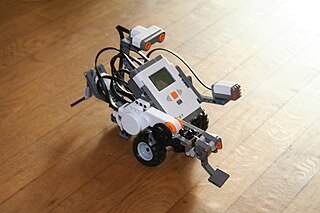
Lego Mindstorms NXT is a programmable robotics kit released by Lego on August 2, 2006. It replaced the Robotics Invention System, the first-generation Lego Mindstorms kit. The base kit ships in two versions: the retail version and the education base set. It comes with the NXT-G programming software or the optional LabVIEW for Lego Mindstorms. A variety of unofficial languages exist, such as NXC, NBC, leJOS NXJ, and RobotC. A second-generation set, Lego Mindstorms NXT 2.0, was released on August 1, 2009, with a color sensor and other upgrades. The third-generation EV3 was released in September 2013.
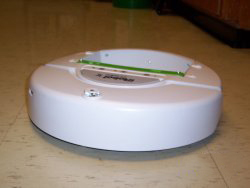
iRobot Create is a hobbyist robot manufactured by iRobot that was introduced in 2007 and based on their Roomba vacuum cleaning platform. The iRobot Create is explicitly designed for robotics development and improves the experience beyond simply hacking the Roomba. The Create replaces its Roomba predecessor's vacuum cleaner hardware with a cargo bay that also houses a DB-9 port providing serial communication, digital input & output, analog input & output, and an electric power supply. The Create also has a 7-pin Mini-DIN serial port through which sensor data can be read and motor commands can be issued using the iRobot Roomba Open Interface (ROI) protocol.
Next Byte Codes (NBC) is a simple language with an assembly language syntax that can be used to program Lego Mindstorms NXT programmable bricks. The command line compiler outputs NXT compatible machine code, and is supported on Windows, Mac OS and Linux. It is maintained by John Hansen, a Mindstorms Developer Program member.

Webots is a free and open-source 3D robot simulator used in industry, education and research.
DialogOS is a graphical programming environment to design computer system which can converse through voice with the user. Dialogs are clicked together in a Flowchart. DialogOS includes bindings to control Lego Mindstorms robots by voice and has bindings to SQL databases, as well as a generic plugin architecture to integrate with other types of backends.
Lego Education is a Lego theme designed specifically for schools that concentrates sets that can be used by education institutions and includes sets that focus on Duplo and Technic themes and contain larger amounts of pieces. The theme was first introduced in 1999.
The World Robot Olympiad (WRO) is a global robotics competition for young people. The World Robot Olympiad competition uses Lego Mindstorms manufactured by LEGO Education. First held in 2004 in Singapore, it now attracts more than 28,000 teams from more than 85 countries.

For Inspiration and Recognition of Science and Technology (FIRST) is an international youth organization that operates the FIRST Robotics Competition, FIRST LEGO League Challenge, FIRST LEGO League Explore, FIRST LEGO League Discover, and FIRST Tech Challenge competitions. Founded by Dean Kamen and Woodie Flowers in 1989, its expressed goal is to develop ways to inspire students in engineering and technology fields. Its philosophy is expressed by the organization as Coopertition and Gracious Professionalism. FIRST also operates FIRST Place, a research facility at FIRST Headquarters in Manchester, New Hampshire, where it holds educational programs and day camps for students and teachers.
The Robot Interaction Language (ROILA) is the first spoken language created specifically for talking to robots. ROILA is being developed by the Department of Industrial Design at Eindhoven University of Technology. The major goals of ROILA are that it should be easily learnable by the user, and optimized for efficient recognition by robots. ROILA has a syntax that allows it to be useful for many different kinds of robots, including the Roomba, and Lego Mindstorms NXT. ROILA is free for anybody to use and to contribute to, as the team has released all documentation and tools under a Creative Commons license.
The Robot App Store is a digital application distribution platform for applications for robots opened to the public on late 2011. The service allows users to browse and download applications that were developed for robots, and published through the RobotAppStore.com website.
ArduPilot is an open source, uncrewed vehicle Autopilot Software Suite, capable of controlling:
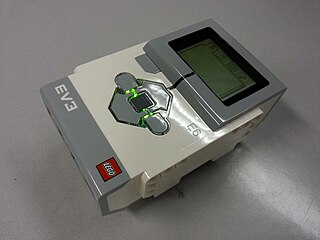
LEGO Mindstorms EV3 is the third generation robotics kit in LEGO's Mindstorms line. It is the successor to the second generation LEGO Mindstorms NXT kit. The "EV" designation refers to the "evolution" of the Mindstorms product line. "3" refers to the fact that it is the third generation of computer modules - first was the RCX and the second is the NXT. It was officially announced on January 4, 2013, and was released in stores on September 1, 2013. The education edition was released on August 1, 2013. There are many competitions using this set, including the FIRST LEGO League Challenge and the World Robot Olympiad, sponsored by LEGO.
Open Roberta is a project within the German education initiative "Roberta – Learning with robots", initiated by Fraunhofer IAIS, which is an institute belonging to the Fraunhofer Society. With Open Roberta Fraunhofer IAIS is looking to encourage children to code by using robots such as Lego Mindstorms, and other programmable hardware systems such as Arduino, BBC micro:bit, and the Calliope mini. The Cloud-approach of the Open Roberta Lab is intended to simplify programming concepts and make it easier for teachers and schools to teach how to code. Open Roberta is free and does not require any installation. The project was initially founded with €1m by Google.org. Users from up to 120 countries now access the platform.

Catrobat is a block-based visual programming language and Open Source Software non-profit project. First released in 2010 by Wolfgang Slany from the Technical University Graz in Austria. The multidisciplinary team develops the programming language and free apps for teenagers to create their own games, animations, music videos, or all other kinds of apps directly on a smartphone based on the Catrobat framework.



